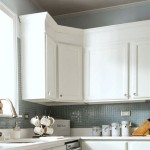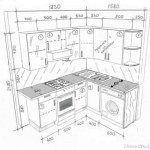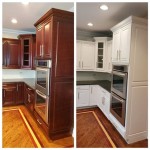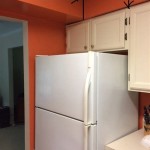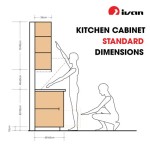Hardware Kitchen Cabinet Handles: A Comprehensive Guide
Kitchen cabinet handles are a crucial element of kitchen design, impacting both functionality and aesthetics. Selecting the right handles can significantly enhance the overall look and feel of a kitchen while providing ease of use. This article delves into the various aspects of kitchen cabinet handles, including types, materials, styles, installation, and considerations for choosing the optimal hardware for a specific kitchen environment.
Cabinet hardware, often an afterthought in kitchen renovations, plays a much larger role than simply opening and closing doors and drawers. It acts as jewelry for the cabinetry, providing a visual accent that complements the overall design scheme. Proper selection should consider the existing style of the kitchen, the color palette, and the desired level of sophistication or practicality.
The choice of handles extends beyond mere visual appeal. Ergonomics and ease of use are paramount. Handles should be comfortable to grip and operate, even when hands are wet or full. The placement of handles, typically dictated by the cabinet's size and function, also influences usability. Thoughtful consideration of these factors contributes to a kitchen that is both beautiful and functional.
The longevity of kitchen cabinet handles is also a critical aspect. High-quality materials and construction ensure that the hardware withstands daily use and maintains its appearance over time. Investing in durable handles reduces the need for frequent replacements and contributes to the overall value of the kitchen.
Types of Kitchen Cabinet Handles
Kitchen cabinet handles are available in a wide variety of types, each offering distinct aesthetic and functional characteristics. Understanding these differences is essential for making an informed decision.
Knobs: Knobs are small, typically round or decorative hardware pieces that are attached to a cabinet door or drawer with a single screw. They are a classic choice, often favored for their simplicity and affordability. Knobs can be made from various materials, including metal, wood, glass, and ceramic, allowing them to complement a wide range of kitchen styles. Their single-point attachment makes them less robust than handles for larger, heavier drawers.
Pulls: Pulls, sometimes referred to as bars, are longer handles that attach to cabinets or drawers with two or more screws. They offer a more substantial grip than knobs and are generally preferred for larger drawers and doors. Pulls come in a variety of shapes and sizes, including straight bars, curved designs, and ornate styles. Their availability in various lengths allows for customization to suit the size and style of the cabinet.
Cup Pulls: Cup pulls, also known as bin pulls, are characterized by their semi-circular or cup-shaped design. They are typically mounted horizontally on drawers and offer a comfortable grip. Cup pulls are often associated with traditional or vintage kitchen styles, but they can also be incorporated into more contemporary designs to add a touch of character.
Appliance Pulls: Appliance pulls are specifically designed for use on refrigerators, dishwashers, and other large kitchen appliances. They are typically larger and more robust than standard cabinet pulls to accommodate the weight and size of these appliances. Appliance pulls often have a thicker diameter and a stronger mounting system to ensure a secure and durable attachment.
Edge Pulls: Edge pulls are mounted on the top or bottom edge of a cabinet door or drawer, creating a clean and minimalist look. They are often used in contemporary kitchens where a seamless appearance is desired. Edge pulls can be made from a variety of materials, including metal and wood, and are available in different lengths to suit various cabinet sizes.
Materials and Finishes for Kitchen Cabinet Handles
The material and finish of kitchen cabinet handles significantly impact their durability, appearance, and overall aesthetic appeal. Careful consideration of these factors is essential for selecting hardware that complements the kitchen's design and withstands daily use.
Metal: Metal is a common and durable material for kitchen cabinet handles. Various metals are used, each offering distinct characteristics.
Stainless Steel: Stainless steel is a popular choice for its durability, corrosion resistance, and modern appearance. It is easy to clean and maintain, making it ideal for high-use kitchens. Stainless steel handles often have a brushed or polished finish, providing versatility in design.
Brass: Brass handles offer a classic and elegant look. They can be polished to a high shine or left with a more muted, antique finish. Brass is a durable material that can withstand daily use, but it may require occasional polishing to maintain its appearance.
Bronze: Bronze handles offer a warm and rustic aesthetic. They are often used in traditional or farmhouse-style kitchens. Bronze is a durable material that develops a natural patina over time, adding to its character.
Zinc Alloy: Zinc alloy is a cost-effective alternative to other metals. It offers good durability and can be finished in a variety of colors and styles. Zinc alloy handles are often used in budget-friendly kitchen renovations.
Wood: Wood handles offer a natural and warm aesthetic. They are often used in rustic or farmhouse-style kitchens. Wood handles can be made from various types of wood, including oak, maple, and cherry. They may require more maintenance than metal handles to protect them from moisture and wear.
Ceramic: Ceramic handles offer a decorative and colorful option. They are often used in vintage or eclectic kitchens. Ceramic handles can be hand-painted or glazed, adding a unique touch to the cabinetry. They may be more fragile than metal handles and require careful handling.
Glass: Glass handles offer a sleek and modern aesthetic. They are often used in contemporary kitchens where a minimalist look is desired. Glass handles can be clear, frosted, or colored, providing versatility in design. They may be more fragile than metal handles and require careful handling.
Finishes: The finish of a cabinet handle refers to the surface treatment applied to the material. Common finishes include:
Polished: Polished finishes provide a high-shine, reflective surface.
Brushed: Brushed finishes offer a matte, textured surface with subtle lines.
Satin: Satin finishes provide a smooth, non-reflective surface.
Antique: Antique finishes replicate the look of aged metal, often with dark undertones.
Matte: Matte finishes offer a non-reflective, smooth surface that minimizes fingerprints.
Factors to Consider When Choosing Kitchen Cabinet Handles
Selecting the appropriate kitchen cabinet handles involves careful consideration of several factors to ensure that the hardware complements the kitchen's design, provides optimal functionality, and withstands daily use.
Kitchen Style: The style of the kitchen is a primary factor in determining the appropriate type and finish of cabinet handles. Traditional kitchens often benefit from ornate designs and classic materials like brass or bronze. Contemporary kitchens typically feature sleek, minimalist designs with stainless steel or brushed nickel finishes. Transitional kitchens can incorporate a mix of styles, blending traditional and modern elements.
Cabinet Design: The design of the cabinets themselves also influences the choice of handles. Shaker-style cabinets, with their clean lines and simple design, often pair well with simple knobs or bar pulls. Raised-panel cabinets may benefit from more decorative handles that complement their ornate details. Flat-panel cabinets can accommodate a variety of handle styles, depending on the desired look.
Functionality: The functionality of the handles is paramount. Handles should be easy to grip and operate, even with wet or full hands. The size and shape of the handles should be appropriate for the size and weight of the cabinet doors and drawers. Larger drawers, in particular, may require longer pulls to distribute the weight and provide adequate leverage.
Ergonomics: Handle placement is crucial for ergonomic comfort. Handles should be positioned at a comfortable height and distance from the edge of the cabinet door or drawer. This ensures that users can easily reach and operate the handles without straining or bending unnecessarily. For upper cabinets, handles are typically placed near the bottom edge, while for lower cabinets, handles are placed near the top edge.
Budget: The budget for cabinet hardware can vary significantly. Knobs are generally more affordable than pulls, while specialized hardware like appliance pulls can be more expensive. Metal handles are typically more expensive than wood or plastic handles. Setting a budget before beginning the selection process can help narrow down the options and ensure that the chosen hardware fits within the overall renovation plan.
Durability: The durability of kitchen cabinet handles is essential for ensuring that they withstand daily use and maintain their appearance over time. High-quality materials and construction are crucial for longevity. Stainless steel and brass are known for their durability and corrosion resistance. Wood handles should be properly sealed and protected from moisture to prevent warping or cracking.
Maintenance: The maintenance requirements of different handle materials and finishes should also be considered. Stainless steel and brushed nickel are relatively easy to clean and maintain. Brass may require occasional polishing to maintain its shine. Wood handles may require periodic sealing to protect them from moisture. Choose materials and finishes that are easy to care for and suit the homeowner's lifestyle.
Personal Preference: Ultimately, the choice of kitchen cabinet handles is a matter of personal preference. Choose handles that complement the kitchen's design, provide optimal functionality, and reflect the homeowner's individual style. Consider factors such as color, shape, and texture when making the final decision. Gathering inspiration from magazines, websites, and showrooms can help visualize different options and narrow down the choices.
By carefully considering these factors, homeowners can select kitchen cabinet handles that enhance the beauty and functionality of their kitchen while providing years of reliable service.

Cabinet Hardware The Home Depot

Best Kitchen Cabinet Hardware 2024

62 Unique Kitchen Cabinet Hardware Ideas For Your Home Best Cabinets Handles

Design 101 Cabinet Hardware Placement Lark Linen

Cabinet Hardware The Home Depot

Trending Cabinet Hardware At Lowe S

7 Unique Kitchen Cabinet Hardware Options

Modket Brushed Satin Brass Gold Modern Kitchen Cabinet Handles Pulls Knobs Hardware Bathroom Drawer Dresser Square Stainless Steel

How To Install Cabinet Handles Ultimate Stress Free Tips

Best Kitchen Cabinet Hardware 2024
Related Posts

